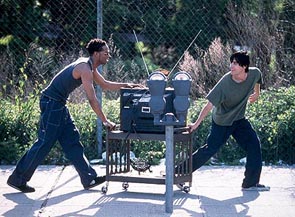|
|
Are You With Us?: Requiem for a DreamBy Ryan MazieJanuary 13, 2011
Requiem starts during the summer in Brooklyn, New York (where Aronofsky was born and raised) with the recently widowed Sara Goldfarb. Sleepwalking through her days, watching infomercial after infomercial, Sara finds joy again when she gets a call to be on a game show. Wanting to fit into her favorite red dress, she starts taking weight loss amphetamine pills and sedatives to curb her sugar addiction. Her son, Henry (Jared Leto), warns her about the pills' addictive nature, but he shouldn’t be talking. Henry and his friend, Tyrone C. Love (Marlon Wayans), are heroin dealers and addicts. Selling drugs to get rich, Tyrone is saving up his money to finally get off the streets and open up a clothing store with Marion Silver. Marion is an addict as well as Henry’s girlfriend, who is pregnant with his child. Caught in the middle of a drug war, causing their supply to dwindle and costs soar, the three are thrown into violent situations and desperate measures to make money and score a hit, while Sara’s addiction is causing frightening hallucinations, causing her to slowly slip into insanity. Trading sex for drugs, health and sanity for weight-loss, and possessions for drug money, Darren Aronofsky delivers a ruthless, relentless, and all too real interpretation of addiction in his adaptation of the same-name 1978 novel by Hubert Selby, Jr. Extremely graphic in depiction, Requiem for a Dream is not for the faint of heart. Slapped with an NC-17 rating (due to an explicit sex scene although I have a feeling the graphic drug content had something to do with it as well), Requiem received a shockwave of criticism when first released. While in no way whatsoever glorifying recreational drug use, some question whether its scared-straight tactics would still give off a negative influence, similar to the controversy surrounding Oliver Stone’s extremely violent, yet socially aware and consequence-showing Natural Born Killers (a movie I found unique but overrated).
|

|
|
|

|
Friday, November 1, 2024
© 2024 Box Office Prophets, a division of One Of Us, Inc.


